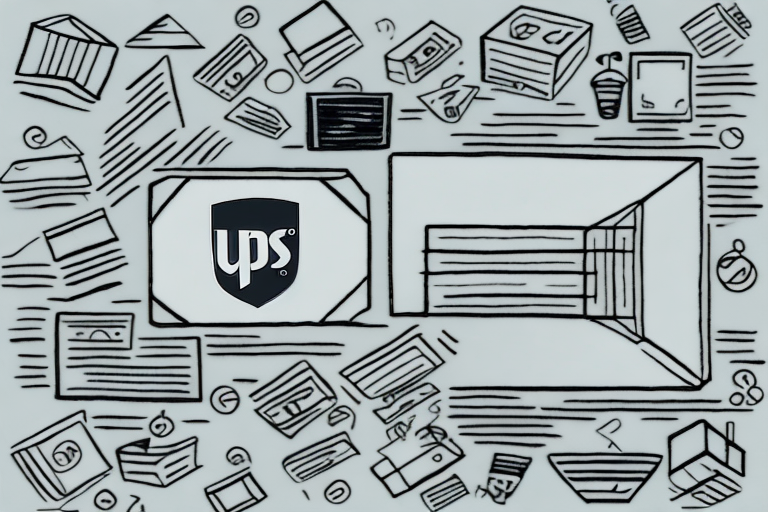Why Shipping Rates Matter for Your UPS Online Store
Shipping rates are a critical component of your UPS online store's success, directly impacting both your profit margins and customer satisfaction. According to a 2023 Statista report, shipping costs account for approximately 20-30% of total e-commerce expenses. If your shipping rates are set too high, customers may abandon their carts or choose competitors offering more affordable shipping options, thereby affecting your sales and brand reputation.
Conversely, setting shipping rates too low can erode your profit margins. Data from the Forbes Business Council highlights that improper shipping rate management can lead to significant losses, especially for small to medium-sized businesses. Therefore, it's essential to balance offering competitive shipping rates that appeal to customers without compromising your profitability.
Another important factor is the distance between your business and your customers. Shipping rates can vary greatly based on geographic location, with longer distances typically incurring higher costs. Utilizing UPS's zone-based shipping rates can help you adjust your rates accordingly, ensuring that you cover your costs while remaining competitive within different regions.
Additionally, the speed of delivery is a key consideration. Offering multiple shipping options, such as standard, expedited, and overnight shipping, can cater to varying customer needs. According to a PrestaShop survey, over 60% of online shoppers are willing to pay extra for faster delivery, presenting an opportunity to increase your revenue by providing premium shipping services.
How to Calculate Shipping Rates for Your UPS Online Store
Calculating accurate shipping rates is vital for maintaining profitability and customer satisfaction in your UPS online store. Various factors influence shipping costs, including package weight, dimensions, destination, and chosen shipping method. UPS provides comprehensive rate calculators that help you determine the most cost-effective shipping options for your business.
To use UPS's rate calculator, follow these steps:
- Enter Package Details: Input the weight and dimensions of your package accurately. Precise measurements ensure that you receive an accurate shipping quote.
- Select Shipping Destination: Specify the destination address to apply the correct shipping zone rates.
- Choose Shipping Method: Select from various UPS shipping methods such as Ground, 2nd Day Air, or Next Day Air, each with different pricing and delivery speeds.
- Review and Compare Rates: Analyze the generated quotes to select the shipping option that best balances cost and delivery time.
It's important to regularly review and update your shipping rates to account for factors like seasonal demand fluctuations and changes in UPS pricing. Additionally, businesses that ship frequently or in large volumes may qualify for discounted rates through UPS's negotiated rate programs, which can further optimize your shipping expenses.
Don't forget to factor in ancillary costs such as packaging materials, insurance, and handling fees. Including these in your shipping rate calculations ensures that your final shipping price covers all related expenses, preventing unexpected costs from impacting your profitability.
Tips for Reducing Shipping Costs on Your UPS Online Store
Minimizing shipping costs without compromising service quality is key to enhancing your UPS online store's profitability. Here are some effective strategies:
- Optimize Packaging: Reduce package dimensions and weight by selecting appropriately sized packaging materials. Efficient packaging not only cuts shipping costs but also minimizes material expenses.
- Negotiate With UPS: Engage with UPS to explore potential discounts or tailored shipping solutions based on your shipping volume. Building a strong relationship with your shipping carrier can lead to more favorable rates.
- Leverage Third-Party Shipping Services: Consider using third-party logistics (3PL) providers that may offer competitive rates or additional shipping benefits.
- Implement a Shipping Cost Calculator: Utilize a shipping cost calculator on your website to display accurate shipping costs to customers upfront, reducing the likelihood of abandoned carts due to unexpected shipping fees.
- Use Regional or Local Carriers: For deliveries within specific regions, partnering with local carriers can offer cost savings and faster delivery times.
Additionally, timing your shipments strategically can result in cost savings. Shipping during off-peak periods may provide access to lower rates, while consolidating multiple orders into a single shipment can reduce per-package costs. Implementing these practices helps streamline your shipping operations and decreases overall expenses.
How to Negotiate Better Shipping Rates with UPS
For businesses with high shipping volumes, negotiating better rates with UPS can lead to significant cost savings. Here are some tips to effectively negotiate favorable shipping rates:
- Research Market Rates: Before entering negotiations, understand the current shipping rates offered by UPS and other carriers. This knowledge provides leverage in discussions.
- Highlight Your Shipping Volume: Emphasize your current and projected shipping volumes, as higher volumes can justify discounts and better rates.
- Commit to Long-Term Contracts: Being open to a long-term partnership with UPS may incentivize them to offer more competitive rates.
- Discuss Specific Needs: Address unique shipping requirements or specific destinations that may benefit from tailored rate structures.
- Request a Dedicated Account Manager: Having a dedicated point of contact at UPS can facilitate better communication and more customized shipping solutions.
Additionally, consider leveraging UPS's negotiated rate programs, which offer businesses with substantial shipping needs the opportunity to receive discounted rates. Engaging in continuous dialogue with your UPS representative about your evolving shipping needs can help maintain favorable rate agreements.
Moreover, staying informed about UPS's promotions or rate adjustments allows you to take advantage of temporary cost reductions or additional services that can further enhance your shipping strategy.
Understanding the Different Types of Shipping Options Available on Your UPS Online Store
Offering a variety of shipping options can cater to diverse customer needs and preferences, enhancing their shopping experience. UPS provides several shipping methods, each with distinct features and pricing:
- UPS Ground: A cost-effective option suitable for non-urgent deliveries, typically offering delivery within 1-5 business days depending on the destination.
- UPS 2nd Day Air: A mid-tier shipping option that ensures delivery within two business days, balancing speed and cost.
- UPS Next Day Air: The fastest shipping method available, providing delivery by the next business day, ideal for urgent or time-sensitive orders.
- UPS Express Critical: An expedited service offering same-day delivery, even for oversized or special handling packages, at a premium cost.
- UPS Freight: Designed for larger shipments, UPS Freight provides reliable services for heavy or bulk items that exceed standard shipping size and weight limits.
- Flat-Rate Shipping: A fixed shipping fee regardless of package weight or destination, beneficial for standard-sized items and simplifying shipping cost calculations.
Selecting the appropriate shipping options ensures that you meet customer expectations while managing shipping costs effectively. An optimal mix of shipping methods can cater to various order sizes, delivery timeframes, and budget constraints, enhancing overall customer satisfaction.
How to Choose the Best Shipping Method for Your UPS Online Store
Choosing the most suitable shipping method for your UPS online store involves balancing cost, delivery speed, and reliability to meet your business objectives and customer expectations. Consider the following factors when selecting shipping methods:
- Package Weight and Dimensions: Heavier or larger packages may be more cost-effectively shipped using UPS Ground or UPS Freight services, whereas smaller packages can leverage expedited shipping options.
- Destination Location: International orders may necessitate different shipping methods compared to domestic shipments, with considerations for customs regulations and longer transit times.
- Delivery Timeframe: Assess whether your customers prioritize fast delivery or cost savings. Offering multiple shipping options allows customers to choose based on their preferences.
- Cost Constraints: Evaluate your budget for shipping expenses and select methods that align with your financial goals without compromising on service quality.
- Tracking and Reliability: Ensure that the chosen shipping methods provide reliable tracking capabilities and consistent delivery performance to maintain customer trust.
By carefully evaluating these factors, you can select shipping methods that not only meet your operational needs but also enhance the overall customer experience, fostering repeat business and positive reviews.
Common Mistakes to Avoid When Setting Up Shipping Rates on Your UPS Online Store
Establishing effective shipping rates requires careful planning and consideration to prevent common pitfalls that can negatively impact your business. Here are some mistakes to avoid:
- Overcharging or Undercharging for Shipping: Accurate calculation of shipping costs is essential. Overcharging can deter customers, while undercharging can erode your profit margins.
- Ignoring Packaging Optimization: Failing to optimize packaging can lead to increased shipping costs. Use appropriately sized packaging to reduce weight and dimensional fees.
- Neglecting to Include Handling Fees or Taxes: Ensure that all additional costs, such as handling fees, taxes, and insurance, are accounted for in your shipping rates to avoid unexpected expenses.
- Limiting Shipping Options: Offering a limited range of shipping options can alienate customers with diverse needs. Providing multiple shipping choices enhances customer satisfaction.
- Not Displaying Shipping Costs Transparently: Hidden or unexpected shipping fees can lead to cart abandonment. Implement transparent shipping cost displays to build trust with your customers.
Avoiding these common errors ensures that your shipping rate structure is both customer-friendly and financially sustainable, contributing to the overall success of your UPS online store.
Strategies for Offering Free Shipping on Your UPS Online Store without Breaking the Bank
Offering free shipping is a popular incentive to attract customers and increase sales. However, it requires strategic planning to implement without incurring losses. Here are effective strategies to offer free shipping sustainably:
- Set a Minimum Order Threshold: Offer free shipping for orders that exceed a certain value. This encourages customers to buy more to qualify for free shipping, increasing your average order value.
- Factor Shipping Costs into Product Pricing: Adjust your product prices slightly to cover the cost of shipping, allowing you to offer free shipping without additional charges to customers.
- Partner with UPS for Volume Discounts: Collaborate with UPS to secure discounted shipping rates based on your shipping volume, making it more feasible to offer free shipping.
- Limit Free Shipping to Specific Items or Categories: Restrict free shipping to high-margin products or select categories to manage shipping costs effectively.
- Offer Free Shipping as Part of Promotions: Implement free shipping during special promotions, holidays, or as a reward for loyal customers, ensuring it aligns with your marketing goals.
By employing these strategies, you can provide the attractive offer of free shipping while maintaining your business's financial health.
How to Use Discounts and Coupons to Increase Sales on Your UPS Online Store
Utilizing discounts and coupons is a powerful method to drive sales and enhance customer loyalty in your UPS online store. Here are some strategies to effectively implement discounts and coupons:
- Offer Welcome Discounts for New Customers: Provide a special discount or coupon code for first-time buyers to encourage them to complete their initial purchase.
- Run Promotions During Holidays and Peak Seasons: Capitalize on high-traffic periods by offering time-limited discounts and coupons to boost sales.
- Implement Loyalty Programs: Reward repeat customers with exclusive discounts or coupons, fostering long-term loyalty and repeat business.
- Target Specific Products or Categories: Use discounts to promote underperforming products or incentivize the purchase of higher-margin items.
- Leverage Email Marketing and Social Media: Promote your discounts and coupons through email campaigns and social platforms to reach a broader audience.
- Set Usage Restrictions: Define clear terms and conditions for discounts and coupons, such as minimum purchase amounts or expiration dates, to control their impact on your revenue.
Strategically deploying discounts and coupons can not only drive immediate sales but also enhance customer engagement and retention, contributing to the sustained growth of your UPS online store.
Ways to Improve Customer Satisfaction through Efficient and Affordable Shipping on Your UPS Online Store
Efficient and affordable shipping is a key determinant of customer satisfaction, which in turn influences repeat business and positive reviews. Here are ways to enhance customer satisfaction through optimized shipping practices:
- Ensure Prompt and Accurate Delivery: Utilize UPS's tracking tools to provide real-time updates, keeping customers informed about their order status and estimated delivery dates.
- Offer Multiple Shipping Options: Provide a range of shipping speeds and methods to accommodate different customer preferences and urgency levels.
- Display Shipping Costs Transparently: Clearly communicate shipping fees during the checkout process to build trust and prevent cart abandonment.
- Implement Reliable Customer Service: Address shipping-related inquiries and issues promptly and professionally, ensuring a positive customer experience.
- Include Packaging Inserts: Add thank-you notes or coupons in your shipments to enhance the unboxing experience and encourage repeat purchases.
By focusing on these areas, you can significantly improve customer satisfaction, fostering loyalty and encouraging word-of-mouth referrals for your UPS online store.
How to Track and Manage Delivery Statuses for Orders on Your UPS Online Store
Effective tracking and management of delivery statuses are essential for ensuring timely and accurate deliveries, which are crucial for maintaining customer satisfaction. UPS offers a suite of tools and services to facilitate this:
- UPS My Choice: A free service that allows customers to manage their deliveries, including customizing delivery preferences and receiving real-time alerts about package statuses. Learn more at UPS My Choice.
- UPS Quantum View: An advanced tracking service designed for high-volume shippers, providing detailed information on all shipments, including in-transit and delivered statuses. More details can be found at UPS Quantum View.
- UPS WorldShip: A comprehensive software tool that allows businesses to manage and track their shipments from a centralized platform, streamlining the shipping process and improving efficiency.
Implementing these tools enables you to monitor shipments effectively, promptly address any delivery issues, and provide customers with accurate delivery information, thereby enhancing their overall experience.
The Impact of International Shipping Fees on Your Bottom Line: What You Need to Know
Expanding your UPS online store's reach to international markets opens up new revenue streams but also introduces additional complexities, particularly related to international shipping fees. These fees can significantly impact your bottom line and must be carefully managed. Here are key considerations:
- Understand International Shipping Rates: Shipping costs vary based on destination country, package weight and dimensions, and selected shipping method. Use UPS's international rate calculators to estimate costs accurately.
- Utilize Cross-Border Carriers: Partnering with UPS's cross-border shipping services can streamline international shipments, offering competitive rates and reliable delivery times.
- Hire a Customs Broker: Navigating customs regulations and tariffs can be complex. A customs broker can assist in managing documentation and compliance, reducing the risk of delays or unexpected fees.
- Implement Transparent Pricing Strategies: Clearly communicate international shipping costs and potential customs duties to customers to prevent cart abandonment and build trust.
By effectively managing international shipping fees, you can expand your UPS online store's global presence while maintaining profitability and providing a positive customer experience.
Best Practices for Handling Returns and Exchanges with Shipping on Your UPS Online Store
Managing returns and exchanges efficiently is vital for maintaining customer satisfaction and protecting your bottom line. Here are best practices to handle shipping for returns and exchanges on your UPS online store:
- Establish a Clear Return Policy: Clearly outline your return and exchange policies on your website, ensuring that customers understand the terms and conditions, including timeframes and eligibility criteria.
- Provide Prepaid Return Labels: Offering prepaid UPS return labels simplifies the returns process for customers, enhancing their experience and encouraging repeat business.
- Offer Multiple Return Options: Allow customers to choose between returning items via UPS Ground or other UPS shipping methods, providing flexibility based on their needs.
- Streamline Internal Processes: Implement efficient internal procedures for processing returns and exchanges, including timely updates to inventory and customer notifications.
- Analyze Return Data: Regularly review return reasons and trends to identify areas for improvement in product descriptions, quality, or shipping processes.
By adopting these best practices, you can manage returns and exchanges smoothly, reducing operational costs and fostering customer trust and loyalty.
Future Trends in E-commerce Shipping and What They Mean for Your UPS Online Store
The e-commerce shipping landscape is rapidly evolving, driven by technological advancements and changing consumer expectations. Staying ahead of these trends can ensure that your UPS online store remains competitive and efficient. Key future trends include:
- Automation and Robotics: The increased use of automation in warehouses and distribution centers enhances efficiency and reduces human errors. Implementing automated systems can streamline your order fulfillment processes.
- Eco-Friendly Shipping Methods: Growing consumer demand for sustainability has led to the development of environmentally friendly shipping options, such as using electric vehicles or drones. Adopting these methods can appeal to eco-conscious customers and reduce your carbon footprint.
- Artificial Intelligence and Machine Learning: Integration of AI and machine learning in logistics allows for predictive analytics, optimized routing, and improved supply chain management, resulting in cost savings and faster delivery times.
- Sustainable Packaging: There is an increasing emphasis on using recyclable and biodegradable packaging materials. Implementing sustainable packaging practices can enhance your brand's reputation and meet regulatory requirements.
- Same-Day Delivery Expansion: As competition intensifies, same-day delivery services are becoming more prevalent. Partnering with UPS to offer same-day delivery can provide a significant competitive advantage.
By embracing these emerging trends, you can position your UPS online store for future growth and success, ensuring that you meet evolving customer expectations and maintain operational excellence.






















